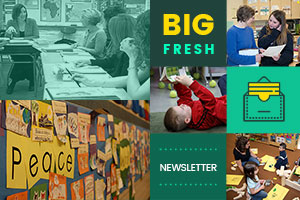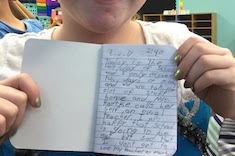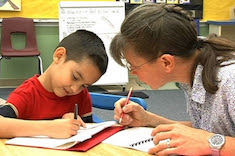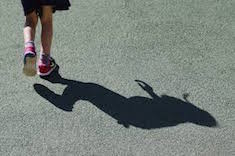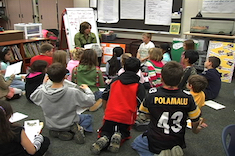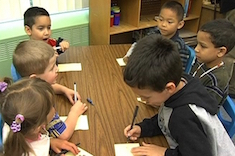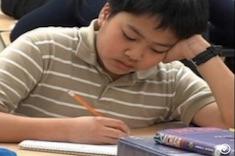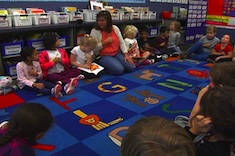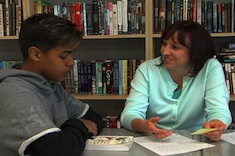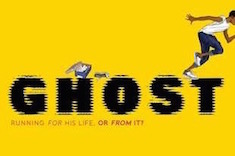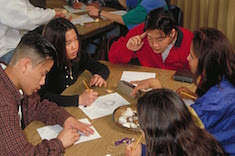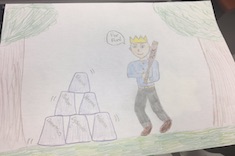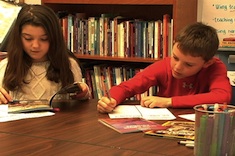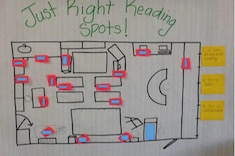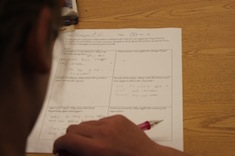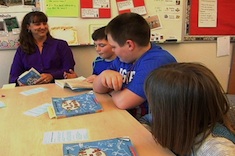Library
Choice Literacy Articles & Videos
The Choice Literacy library contains over 3,000 articles and 900 videos from 150+ contributors. Classic Classroom and Literacy Leadership subscribers have access to the entire library. Content is updated continuously, with five to six new features published each week.
Latest Content
The Big Fresh October 28, 2017 Blind Spots
We rethink rubrics in this week’s Big Fresh.
Resisting Rubrics
Matt Renwick explains why sometimes the best way to grow reading abilities in students is to resist rubrics.
Moves for Struggling Writers
Here are Matt Renwick's three favorite moves for helping struggling writers.
The Big Fresh October 21, 2017 Cheese Emergency
We consider struggling learners in this week’s Big Fresh.
They Don’t Read at Home
Cathy Mere suggests strategies for working with struggling students who read very little at home.
Big Picture to Close-Up Lens: Conferring with Kellan
Katrina Edwards confers with first grader Kellan about her love of the Danny book series, moving from a "big picture" discussion of patterns in the book and Kellan's reading strategies, to close-up decoding of individual words.
Tools for Striving Writers
Sometimes a student just. won’t. write. Melanie Meehan shares her favorite tools in her bag of tricks to get the pencil or pen moving across the page.
The Big Fresh October 14, 2017 More Heart, Less Head
We look at improving read alouds in this week’s Big Fresh.
Using Read Alouds to Build Fluency
Tara Barnett and Kate Mills find an ingenious way in the upper elementary grades to help their struggling readers develop fluency through read alouds.
Color-Symbol-Image: A Thinking Routine for Read Alouds
Andrea Smith uses the Color-Symbol-Image thinking routine during read alouds to promote deeper reflection among students.
More Nonfiction Read Alouds
Franki Sibberson shares strategies for incorporating more nonfiction into read-aloud times throughout the day.
First-Grade Minilesson: Emotions in Writing
Katrina Edwards reads aloud a Kate Messner mentor text to build an anchor chart on emotions with her first graders.
Daily Reflection Rubric
Mark Levine always has a few students each year in his middle school classroom who are stunned by their poor grades, even when they clearly aren't meeting expectations. He develops a rubric to enable students to monitor and reflect on their learning behaviors daily.
The Big Fresh October 7, 2017 Tell Me Everything
We look at self-assessment and reflection in this week’s Big Fresh.
Using Student Checklists in Literacy Intervention
Stephanie Affinito explains how to use student checklists in literacy intervention.
Assessment During On-Demand Writing
Tara Barnett and Kate Mills combine an engagement inventory and an on-demand writing assessment to get a full picture of skills and habits in their classroom community.
First-Grade Reading Share: Connections
Bitsy Parks helps her first-grade students complete “thumb reflections” on making connections in reading early in the year by modeling connections from three conferences in a whole-class share session.
The Big Fresh September 30, 2017 This Class
We look at learning from failure in this week’s Big Fresh.
Eighth-Grade Conference: Empathetic Reading
Christy Rush-Levine confers with eighth grader Julian about his strengths as an empathetic reader.
Great Books for African American Boys
Shari Frost deals with the failure of a classic read-aloud text to reach young African American boys by finding more engaging books for them.
Reflecting on the L
Mark Levine wonders if his middle school students are spending enough time reflecting on the L in K-W-L, so he creates a form to help.
The Big Fresh September 23, 2017 Plain Vanilla
We explore visual literacy in this week’s Big Fresh.
Sketching Your Way to a Big Idea
Tara Barnett and Kate Mills work with eighth graders who struggle to articulate big themes in literature. A breakthrough comes when they have the option of sketching their thoughts.
Exploring Text Features
Melanie Meehan works with a small group to talk through how nonfiction text features might enhance their informational writing.
Visual Expectations in the Classroom
Heather Fisher finds the key to independence for many first graders is lots of visual reminders in classrooms.
Giving Graphic Organizers a Go
Mary Lee Hahn is skeptical about how her fifth-grade students might use graphic organizers. But once she tries them alongside students, she begins to see their utility.
The Big Fresh September 16, 2017 What Rules?
We look at ways to improve student groups in this week’s Big Fresh.
Gradual Release of Responsibility in Small Groups
Tara Barnett and Kate Mills develop a process of pre-assessment, careful planning, and systematic recordkeeping to up the value of their small groups.
Talk Expectations in Reading Groups
Gigi McAllister assists a group of students who are trying out bookmarks of discussion prompts for literature groups.
Better Student-Led Literature Discussions
Gigi McAllister tries student-led discussion groups in her fourth-grade classroom, with disastrous results. She regroups the following year with multiple lessons, anchor charts, and preparation to ensure success.
Browse Content By
Type
Category
- Assessment Tools
- Big Fresh Archives
- Booklists
- Choice Numeracy
- Classroom Design
- Common Core
- Community Building
- Conferring
- Content Literacy
- Digital Literacy
- English Language Learners
- Equity
- Family Relations
- Free Samples
- Guiding Groups
- Leadership
- Literacy Coaches
- Mentor Texts
- Minilessons
- New Teacher Mentors
- Podcasts
- Poetry
- Quote Collections
- Reading Strategies
- Self Care
- Struggling and Striving Learners
- Talking and Listening
- Teacher Study Groups
- Teaching Reading
- Teaching Writing
- Word Study and Vocabulary
Author
- Melissa Quimby
- Nawal Qarooni
- Gwen Blumberg
- Julie Cox
- The Lead Learners
- Hannah Tills
- Josie Stewart
- Ruth Metcalfe
- Mallory Messenger
- Becca Burk
- Jodie Bailey
- Vivian Chen
- Mary Brower
- Tiffany Abbott Fuller
- Stephanie Affinito
- Ruth Ayres
- Leigh Anne Eck
- Heather Fisher
- Shari Frost
- Julie Johnson
- Suzy Kaback
- Gigi McAllister
- Shirl McPhillips
- Melanie Meehan
- Cathy Mere
- Debbie Miller
- Tara Barnett and Kate Mills
- Tammy Mulligan
- Dana Murphy
- Bitsy Parks
- David Pittman
- Brenda Power
- Heather Rader
- Matt Renwick
- Mandy Robek
- Christy Rush-Levine
- Gretchen Schroeder
- Jen Schwanke
- Brian Sepe
- Katherine Sokolowski
- Stella Villalba
- Jennifer Vincent
Grade Level
Choice Literacy Membership
Articles
Get full access to all Choice Literacy article content
Videos
Get full access to all Choice Literacy video content
Courses
Access Choice Literacy course curriculum and training

